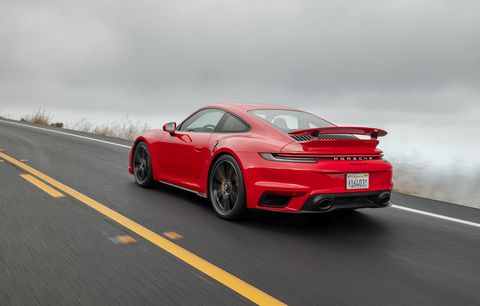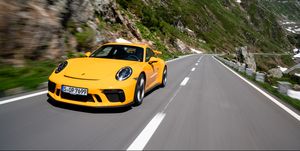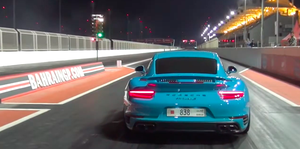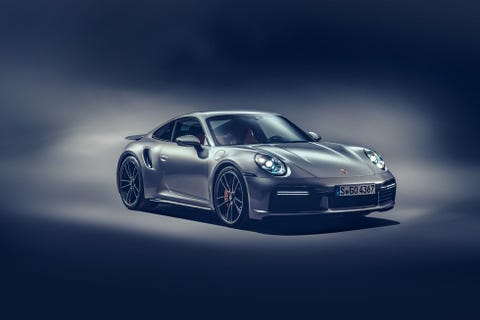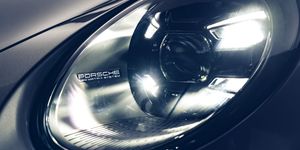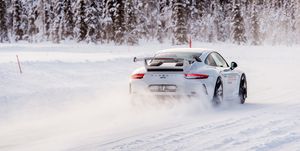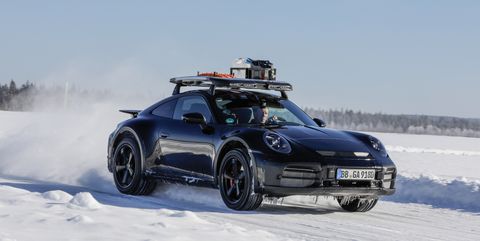You may remember the first Porsche 911 Turbo when it debuted at the Paris auto show in 1972. Being an Autoweek reader, you probably bought one two years later when the model came here to the U.S. I bet you raced it, too, didn’t you? Heck, you had the lap record at your local track that stood for a full year, when the next Porsche Turbo came along and you broke your own record. And as such, you knew, perhaps all too well, the crazy dangerous “handling challenges” resulting when that mighty turbo “snail” kicked in and you suddenly found the huge engine hanging way out aft of the rear axle terrifyingly began producing twice the horsepower, seemingly at will. This was infamously known as “turbo lag,” and when the lag stopped and the turbo came on, unless you were Jackie Ickx or Derek Bell, you had better have that thing pointed straight. Even Porsche, in typical German understatement, recalls that first Turbo with some degree of fright.
“The massive amount of power generated by the turbocharger was usually associated with a drastically reduced engine life expectancy, extreme throttle sensitivity and even more capricious handling.”
The manufacturer is admitting those early cars made scary power.
Over the years Porsche refined and improved the Turbo almost continuously, first addressing turbo lag and its inherent, terrifying sudden rise in boost pressure by incorporating boost pressure control via an exhaust bypass valve, a trick brought directly from its race cars of the day. With refinement, output continued to march up, from 234 hp in the first U.S. spec Turbo in 1976, to 261 hp from a new 3.3-liter engine in 1977, to 282 in 1987, 315 in 1991, 355 from a 3.6-liter flat-six in 1993 and so on until today's all-conquering Turbo.
Hence, the 2021 911 Turbo S you see here is the culmination of almost 50 years of 911 Turbos, from those downright dangerous early dalliances in the dark arts of der kompressor to today’s darn-near perfect, fully sorted sports car. In fact, there are so many things on the 2021 Turbo you could write a book about it. Unfortunately, you get only 1,000 more words.
Ach du leiber! Wo sind meine schnecken?
Let’s start under the rear deck lid. The 3.8-liter twin-turbo flat-six makes 640 hp, 60 more than its immediate predecessor (and 406 more than that first 911 Turbo). The two turbos use variable turbine geometry, or VTG, to balance power and boost to levels far easier to handle than early units. Torque is up to 590 lb-ft, too, a peak figure available almost wherever on the tach you want to floor the throttle and get it, unlike the previous 911 Turbo S that only hit peak torque briefly in overboost mode.
That power goes to all four wheels through a Turbo-tuned eight-speed PDK dual-clutch transmission, with paddle shifters of course. (Here is the part where you say, “If it ain’t got no manual, I ain’t-a buyin’ one.” Go ahead, say it, so we can get over it and move on.) That torque then goes to all four wheels via an improved Porsche Traction Management all-wheel-drive system. Among the enhancements to that is a transfer case that can route up to 368 of the craft’s 590 lb-ft of torque—that’s 62% for those good at math—to the front wheels. A handy readout on the dash shows you how much torque is going where.
The new 911 Turbo S has a wider track, wider tires and a wider chance for fun on the road. Track is 0.39 inch wider in front and 1.65 inches rear. Twenty-inch front wheels are wrapped with 255/35 Pirelli P Zero tires, while the rears get 21-inch wheels and 315/30 P Zeros. The wheels themselves are wider, too, to minimize sidewall overhang.
Shock stiffness is controlled by a new-generation Porsche Active Suspension Management system which operates faster and with more precision than before. The faster-reacting dampers mean Porsche can offer a PASM Sport Suspension on the 911 Turbo S that is still just as comfy in normal mode despite being 10 mm (0.39 inch) lower in ride height. The Porsche Dynamic Chassis Control—the active antiroll system—has a new setup in this configuration and compensates for roll more quickly. (You remember PDCC, right? Active hydraulic cylinders control the ends of the stabilizer bars, raising or lowering them as needed, almost completely eliminating body roll.)
Stopping the whole rig are Porsche Ceramic Composite Brakes, with 420 mm (10 mm larger) brake rotors in front clamped by momentum-frying 10-piston (yes, 10!) calipers. Ten-piston calipers! I remember when six-piston calipers were cool.
Finally, Porsche Active Aerodynamics, aka PAA, helps keep the 2021 911 Turbo S on the ground, controlling cooling flaps in front and a lighter, larger rear wing in back. PAA can even act as an air brake when getting on the binders at high speeds.
So, then, how does it drive? Oh, man …
The polite young man arrived in the red Porsche 911 Turbo S at exactly 8 a.m. sharp wearing latex gloves on his hands and one of those N95 face masks on his face.
“It’s all wiped down, I left the key in the center console,” he said, staying 8-12 feet away at all times, perhaps smiling behind the mask. “We’ll come get it at 2.”
That would be six hours. In case you haven’t heard, things are different now, even in the pampered, rarefied air of sports car delivery. The 2021 911 Turbo was originally supposed to be introduced at Laguna Seca, but that was canceled when pretty much everything else in the world was canceled. So Porsche emailed a pile of PDFs and dropped the 911 Turbo off for a day. Or rather, six hours. I was glad to get it.
Immediately I jumped in and fired that suckah up. There is no longer a key, just a twist-switch, and yes, it’s on the left. Flipper switches on the left of the steering wheel adjust what you see on the console in front of you, everything from tire pressures and temperatures to torque distribution and lateral grip measured in gs. On the lower right of the steering wheel is a round knob by which you adjust the drive modes. There is normal, sport, sport-plus, individual and, a new one, wet.
I knew right where I was headed and maybe you do, too—a series of delightful mountain twisties only about 15 minutes from my front door. On the way a message arrived from my friend at Porsche: “If you want, you can keep it all day and we’ll get it tomorrow morning. Would you like to do that?”
Well, duh.
On city streets and on the freeway I kept the Turbo S in normal mode, and it felt like it controlled that very minor front-end bob you can get with 911s due to having all that mass behind the rear axle levering the front end off the ground. Maybe you’ve noticed it too, over the years, in all your 911s. Maybe I’ve just been hallucinating.
Up on the curvy mountain road I first left it in normal for a while. Even in normal the 911 Turbo S is better than almost any driving experience you will ever have, save for a very short list of road cars made by companies all racing in F1. In back-to-back-to-back curves in normal it doesn’t feel tail-heavy at all, nor tail-happy. As hard as I pushed it, the rear remained planted, even when I lifted off at the wrong time (on purpose) just to see what would happen. You could not have done that in 1974.
I tried reaching over to a separate toggle on the right of the dash that firmed up the shocks. This was better but just a little choppy. So I rolled the drive mode wheel over to sport-plus, and all of a sudden everything fell into place. All those acronyms you read up above lined up in perfect synchronicity and the 911 Turbo S just swallowed curves like a Weihnachts reveler swallows gluehwein at a Christkindlmarkt. The balance was perfect, again, no rear-end bias at all, that I could feel. I had to really push it to get any understeer, and only then when I was trying like Joie Chitwood to do so. The steering remained precise—it does not change as you adjust the drive modes. The 911 just tracked through all the curves.
I drove all day.
The next morning they were coming for the Turbo S at 9 a.m. I was back up in the hills just after sunrise. You know, for further research. The car was just as precise the next day. For someone like me who has become something of a Ferrari and McLaren snob, I was amazed to be reintroduced to a Porsche 911 Turbo after so many years. It truly competes with those fine rides. Especially in price.
The 2021 Porsche Turbo S Coupe that I drove is priced at $204,850; the 911 Turbo S Cabriolet is $217,650. That’s including the destination charge but not any options. I haven’t seen a price list for options, but I gotta think you could get into the upper half of the 2s pretty easily. And you know what? It’d still be worth it.
Both 911 Turbo S Coupe and Cabriolet will be available for ordering soon and in dealer showrooms late this year. How does it compare to McLarens and Ferraris? The Porsche is definitely more comfortable than any McLaren and even a little more comfortable than an F8 Tributo. It might be just as fast on a mountain road, depending on who’s driving it. Or it might not. The thing is to get one of each and decide for yourself.
Now if you’ll excuse me, I have to formulate a business plan for a long-term 911 Turbo test car from Stuttgart. Auf wiedersehen, baby.






